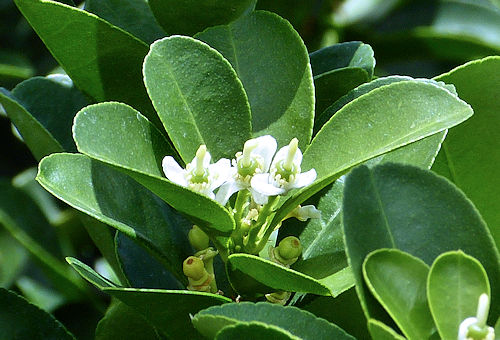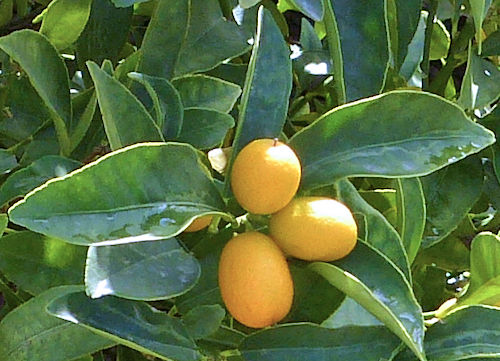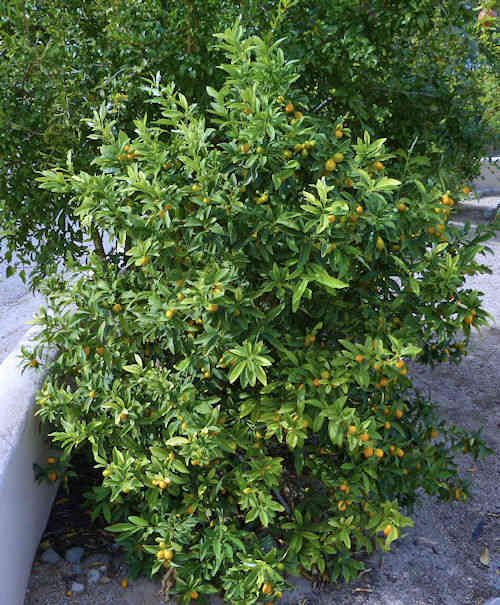Growing Kumquats:
Citrus japonica
Back to Fruit, Berries and Nuts
Botanical Overview
Members of the Citrus family (Rutaceae) and Citrus genus, Kumquats are more cold hardy than most cultivated citrus and have smaller fruit.
Description
Form:
Shrub.
Lifespan:
Productive up to 50 years in a good location with proper care.
Leaf retention: Evergreen.
Growth rate: Slow.
Mature Size:
8-25' (2.4-7.6m) high and as wide.
Flowers:
White, five petals, sweetly fragrant, borne singly or in a cluster of three or four.
Bloom:
Mid spring into fall, or throughout the year in regions without freezes.
Self-fruitful:
All Kumquat cultivars self-pollinate.
Years before fruiting:
3 years after grafting.
Fruit:
Oval or round, golden yellow to reddish orange, 1-1.5" (2.5-3.8cm) diameter, with a sweet
edible rind and tart to sweet flesh. The entire fruit, except seeds, is eaten.
Kumquat itself has no specific flavor except sweet-sour, unlike orange / mandarin, lemon,
lime and grapefruit. The fruit make great fresh eating when the plant is fed sufficient
organic fertilizer, water and sun to produce a thick, sweet, dark orange rind.
Months for fruit to ripen:
6, depending on cultivar and micro-climate. The fruit are ripe when fully orange with
no trace of green, usually in December. They do not ripen further after harvest.
Storage after harvest: At room temperature, up
to 3 days, or refrigerate up to 2 weeks.
Leaves:
Glossy green, ovate. Citrus leaves have a tendency to turn pale-green or yellow in cold
weather. When temperatures warm in the spring, the leaves will green up.
Stems:
Few or no thorns. Densely branched. The bark is prone to sunscald if not shaded by leaves
or covered by tree trunk paint, especially in higher temperatures.
Roots:
Usually grafted on Trifoliate Orange (Citrus trifoliata) rootstock because its own roots
do not allow it to flourish. This rootstock grows slowly, however, and it will take many
years before the roots are deep enough to go without water for 4 weeks.
Cultivars and Hybrids of Note:
'Meiwa' – a nearly round shape, sweet thick
rind and pulp, the sweetest tasting cultivar, 1.5" (3.8cm) diameter.
'Nagami' – an oval shape with sweet rind
and tart pulp, a uniquely sweet-sour flavor, eaten whole, about 1" (2.5cm) diameter.
This cultivar is more vigorous and hardy than others and grows faster.
'Nordmann Seedless' is a variation.
'Marumi' – a round shape, with sweet rind
and pulp, intermediate in sweetness between Nagami and Meiwa. The flesh can be dry,
1" (2.5cm) diameter.
'Fukushu' / 'Changshou' – a hybrid, possibly
kumquat-mandarin, oval with a depressed apex, sweet rind and mild tart pulp, 1-1.5"
(2.5-3.8cm) long, less cold hardy.
The spreading dwarf tree is thornless, has larger leaves, and is 6-10' (1.8-3m) tall.
Limequat – a hybrid of kumquat and Key lime,
with a desirable lime-like flavor and a sweet, edible rind, but far less cold-hardy.
Wildlife: Kumquat attracts bees, insects, birds, and
is a food plant for the Giant Swallowtail butterfly caterpillar – see Pests, below.
Mammals may strip the bark off of young shrubs, cut off small branches to test edibility,
consume fallen fruit, or climb the shrub to eat the fruit.
Toxic / Danger:
Possible thorns.
Origin:
Asia.
Cultivation and Uses
USDA hardiness zones:
8b-11.
Chill hours: None.
Heat tolerant: Less than other citrus members.
Drought tolerant: Moderate.
Sun:
In very hot climates, afternoon shade, preferably deciduous, is necessary to reduce heat and
water stress. In winter, full all day sun helps speed fruit ripening.
Avoid reflected heat.
Planting:
Place the shrub in a sunny location with deciduous afternoon shade. Do not position it next
to a frequently watered location, such as grass. Make sure there is enough space for the
shrub to grow to its full width and height.
The best time to plant is after the danger of frost is past, in late winter or early spring.
Plant the shrub so that the root crown is 1-2" (2.5-5cm) above ground level. The top roots must extend out from the trunk, just above, and uncovered by, soil. The soil should gradually slope from the trunk down to the drip line.
Kumquat can be grown in large containers. Indoors, in cold climates, the shrub should be placed near a large, south-facing window.
The best time to plant is after the danger of frost is past, in late winter or early spring.
Plant the shrub so that the root crown is 1-2" (2.5-5cm) above ground level. The top roots must extend out from the trunk, just above, and uncovered by, soil. The soil should gradually slope from the trunk down to the drip line.
Kumquat can be grown in large containers. Indoors, in cold climates, the shrub should be placed near a large, south-facing window.
Soil:
Well draining to prevent root rot. Do not amend the soil when planting. The roots will adjust
to the native soil surrounding the planting hole.
Fertilize:
In desert soil, never use a chemical fertilizer to avoid salt buildup. Apply an organic
fertilizer, starting three months after planting, every three months from mid-February to
late September. Apply plant micronutrients in irrigation water three times a year in
February, May, and August. Do not fertilize after September to keep the plant from
producing new growth that will be harmed by early frost.
Kumquat shrubs are small and grow slowly, so they need less fertilizer than most citrus trees. These shrubs are prone to zinc deficiency, signaled by smaller leaves, reduced shoot length and possibly yellow blotches between green leaf veins, so application of plant micronutrients is necessary.
Kumquat shrubs are small and grow slowly, so they need less fertilizer than most citrus trees. These shrubs are prone to zinc deficiency, signaled by smaller leaves, reduced shoot length and possibly yellow blotches between green leaf veins, so application of plant micronutrients is necessary.
Water after becoming established:
Deep water for 1.5 hours, to a 3' (1m) depth,
every 1-2 weeks to maintain the fruit crop.
Inward leaf curling, when the leaves are uniformly green, and fruit drop, are signs of
insufficient water.
At other times, deep water every two weeks in hot weather and every 3-4 weeks in cool weather.
Water near the drip line, not at the trunk. Solid yellow leaves are a sign of overwatering.
Mulch:
Apply organic mulch inside the drip line and 8" (21cm) away from the trunk to reduce soil
evaporation and reduce root zone heat and cold stress.
First Year Care:
Deep water once a week, away from the trunk, for one hour.
Prune:
Immediately remove any stems growing from below the graft on the trunk. Those branches are
rootstock, not fruit stock, and will produce inferior fruit.
Remove dead, damaged, crossing, or malformed branches in spring before summer heat. If any
branches above the graft have an angular cross-section (malformed) rather than being round,
remove them because they will not fruit well.
Avoid pruning up from the bottom to expose the trunk. All citrus do better as shrubs so that the entire trunk is shaded by leaves. If already exposed, the trunk should be painted with tree trunk paint to avoid sunscald.
Remove grass and other plants under the canopy that can compete for water and nutrients by hand-pulling, not with tools that can damage roots close to the surface.
Avoid pruning up from the bottom to expose the trunk. All citrus do better as shrubs so that the entire trunk is shaded by leaves. If already exposed, the trunk should be painted with tree trunk paint to avoid sunscald.
Remove grass and other plants under the canopy that can compete for water and nutrients by hand-pulling, not with tools that can damage roots close to the surface.
Litter: Fruit drop.
Propagation:
Kumquat cuttings are grafted onto rootstock from other citrus. Roots produced by kumquat seed
or planted cuttings are very weak and do not allow the plant to thrive.
Pests:
The caterpillar of the Giant Swallowtail Butterfly resembles bird poop and has white and black
and/or brown splotches. On a large plant it will cause no harm.
On a small plant, relocate it to a large citrus. The fruit may need to be sprayed with a
Habanero Chili/Garlic Spray to keep insects away.
Distorted leaf shapes are a sign of thrips, which do no real damage. Thrips are attracted to plants that are given too much nitrogen or are overwatered.
See Citrus: Diseases and Disorders
Distorted leaf shapes are a sign of thrips, which do no real damage. Thrips are attracted to plants that are given too much nitrogen or are overwatered.
See Citrus: Diseases and Disorders
Uses: Ornamental, edible fruit eaten fresh, sliced and
dried in a dehydrator, or cooked as jam or marmalade.
Comments
The former scientific genus for this species was Fortunella.
Do you have additional information or a different experience for these plants that you would like to share? Email info@GardenOracle.com. All contributions are welcome and appreciated.
Do you have additional information or a different experience for these plants that you would like to share? Email info@GardenOracle.com. All contributions are welcome and appreciated.



Citrus japonica 'Nagami': Nagami Kumquat
Latest update: May, 2025
© 2008-2025 by GardenOracle.com

